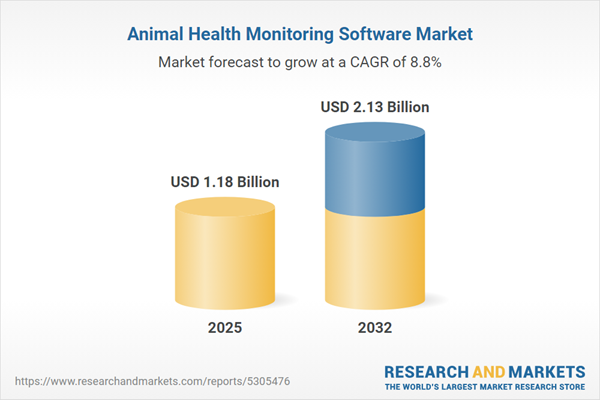Speak directly to the analyst to clarify any post sales queries you may have.
The Animal Health Monitoring Software Market is evolving rapidly as digital solutions reshape veterinary care and livestock management. Increased reliance on connected platforms, advanced data analytics, and early intervention tools is enabling businesses to enhance animal health outcomes while streamlining operations.
Market Snapshot: Animal Health Monitoring Software Market Highlights
According to this latest research, the market expanded from USD 1.08 billion in 2024 to USD 1.18 billion in 2025 and is projected to reach USD 2.13 billion by 2032 at a CAGR of 8.76%. These robust figures reflect strong growth potential in both the companion animal and livestock segments, driven by the need for real-time health tracking, predictive diagnostics, and seamless integration with veterinary practice management.
Scope & Segmentation of the Animal Health Monitoring Software Market
- Animal Types: Companion animals (cats, dogs) and livestock (aquaculture, cattle, poultry, swine)
- Deployment Modes: Cloud, hybrid, and on premise models designed to meet diverse operational and regulatory needs
- Solution Types: Services (consulting, support, training) and software (analytics, mobile, monitoring)
- End Users: Farms (commercial, small scale), research institutions, and veterinary clinics
- Geographies: Americas (United States, Canada, Mexico, Brazil, Argentina, Chile, Colombia, Peru), Europe, Middle East & Africa (United Kingdom, Germany, France, Russia, Italy, Spain, Netherlands, Sweden, Poland, Switzerland, United Arab Emirates, Saudi Arabia, Qatar, Turkey, Israel, South Africa, Nigeria, Egypt, Kenya), Asia-Pacific (China, India, Japan, Australia, South Korea, Indonesia, Thailand, Malaysia, Singapore, Taiwan)
- Key Companies: Zoetis Inc., Merck & Co., Inc., Boehringer Ingelheim International GmbH, DeLaval Holdings AB, SAS Institute Inc., SCR Dairy Ltd., Nedap N.V., Datamars SA, Agri-Tech eSense Solutions Pvt. Ltd., FarmWizard Ltd.
Key Takeaways for Senior Decision-Makers
- Integrated animal health monitoring solutions enable proactive intervention, leading to lower treatment costs and improved operational efficiency.
- Predictive analytics and artificial intelligence enhance disease detection and enable informed, timely clinical decisions for both companion animals and livestock.
- The adoption of hybrid and cloud-based platforms supports flexibility, ensuring scalability for enterprise farms and secure data management for research and regulated institutions.
- Regional diversity affects adoption rates: Americas lead with precision agriculture investments, EMEA innovates under rigorous standards, and Asia-Pacific sees scalable implementations in high-volume livestock operations.
- Collaboration among technology vendors, consultancies, and academia accelerates development of robust, data-driven diagnostic algorithms and user-centric platforms.
- Service diversification, from consulting to support, is essential to facilitate seamless deployment and user proficiency across stakeholder groups.
Tariff Impact: Navigating Operational and Supply Chain Challenges
Recent imposition of United States tariffs on imported electronic components has driven up procurement and operational costs for animal health monitoring technology providers. Companies have responded by reevaluating sourcing strategies, exploring local manufacturing partnerships, and embedding tariff compliance services into their business offerings. This environment has further highlighted the need for resilient supply chain management, flexible pricing strategies, and continuous adaptation to shifting regulatory requirements.
Primary Keyword: Animal Health Monitoring Software Market
The animal health monitoring software market continues to evolve with rapid digital transformation. Advanced platforms integrate sensors, cloud analytics, and mobile technology across veterinary and agricultural contexts, supporting early disease detection and personalized treatment while promoting data-driven decision-making across end-user environments.
Methodology & Data Sources
This report utilizes a rigorous research methodology, combining in-depth interviews with veterinarians, livestock managers, technology vendors, and academics, alongside systematic secondary reviews of industry publications and regulatory filings. Data triangulation and validation processes ensure credible, unbiased results to support confident decision-making.
Why This Report Matters
- Uncovers strategic growth opportunities through in-depth segmentation and regional analysis
- Equips decision-makers with actionable intelligence on technology, supply chain, and regulatory shifts
- Offers insight into trends influencing both companion animal and livestock health management markets
Conclusion
The animal health monitoring software market is poised for sustained expansion. Companies that invest in integrated digital solutions, robust partnerships, and supply chain adaptability will be best positioned to lead in proactive animal care and operational excellence.
Additional Product Information:
- Purchase of this report includes 1 year online access with quarterly updates.
- This report can be updated on request. Please contact our Customer Experience team using the Ask a Question widget on our website.
Table of Contents
3. Executive Summary
4. Market Overview
7. Cumulative Impact of Artificial Intelligence 2025
Companies Mentioned
The companies profiled in this Animal Health Monitoring Software market report include:- Zoetis Inc.
- Merck & Co., Inc.
- Boehringer Ingelheim International GmbH
- DeLaval Holdings AB
- SAS Institute Inc.
- SCR Dairy Ltd.
- Nedap N.V.
- Datamars SA
- Agri-Tech eSense Solutions Pvt. Ltd.
- FarmWizard Ltd.
Table Information
| Report Attribute | Details |
|---|---|
| No. of Pages | 182 |
| Published | October 2025 |
| Forecast Period | 2025 - 2032 |
| Estimated Market Value ( USD | $ 1.18 Billion |
| Forecasted Market Value ( USD | $ 2.13 Billion |
| Compound Annual Growth Rate | 8.7% |
| Regions Covered | Global |
| No. of Companies Mentioned | 11 |









